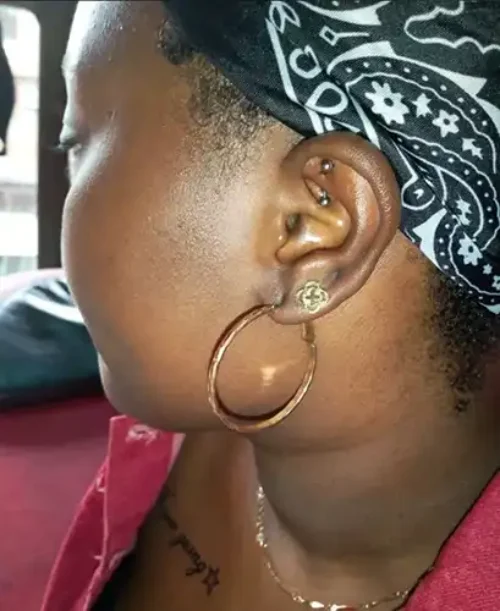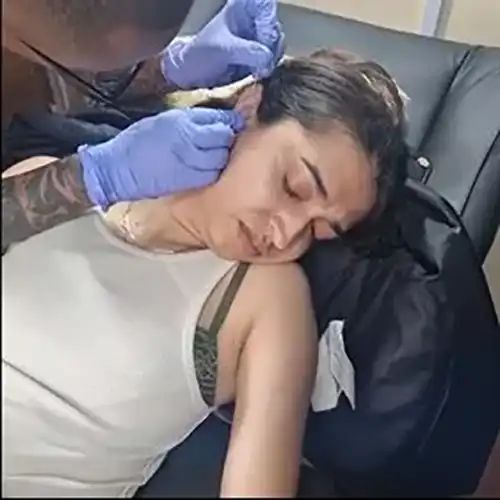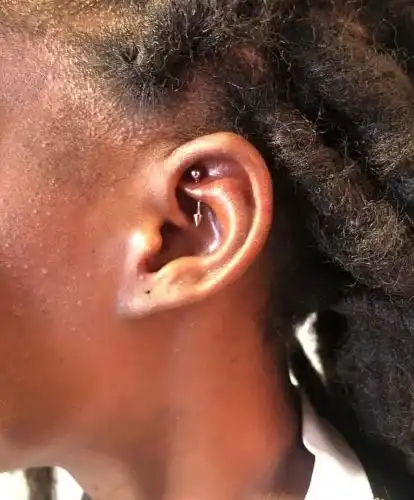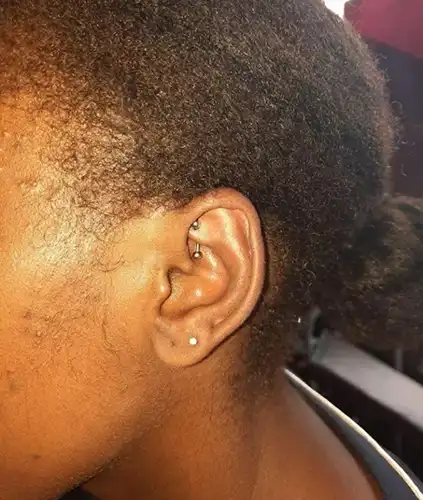Rook Piercing in Nairobi, Kenya
A rook piercing is a type of ear cartilage piercing located on the anti-helix, the ridge of cartilage between the inner conch and the outer ear. It is named after the part of the ear it goes through, which is a thicker area of cartilage, making it a bold and distinctive choice for body art enthusiasts.
Rook Piercing
Key Characteristics of a Rook Piercing:
- Placement: The piercing is done vertically through the anti-helix ridge, giving it a unique, tucked-away appearance.
- Jewelry Options: Common jewelry for rook piercings includes curved barbells, small captive bead rings, or dainty hoops.
- Pain Level: Because the cartilage is thick, the procedure is often considered moderately painful compared to softer-tissue piercings.
- Healing Time: Typically takes 6–9 months to fully heal, although initial healing can happen in about 2–3 months with proper care.
Why Choose a Rook Piercing?
- Unique Style: It’s a less common cartilage piercing, making it a standout choice for those who want something trendy but not overdone.
- Customizable: With a variety of jewelry options, you can style it to match your vibe—whether bold or minimalist.
Considerations before getting a Rook Piercing
Before getting a rook piercing, it’s essential to consider several factors to ensure that it’s the right choice for you and that you have a positive and safe piercing experience. Here are some considerations to keep in mind:
- Piercing Studio and Piercer
– Research reputable piercing studios with experienced and skilled piercers. At Rebel Inks Tattoo Removal and Piercings Parlour we have extensive experience and experienced team that is geared to offer you the best services Contact Us Today for further consultation and scheduling
– Check for reviews from previous clients.
– Ensure the studio follows strict hygiene and sterilization protocols.
- Pain Tolerance
– Understand that piercings involve discomfort and pain, and pain tolerance varies from person to person.
– If you have a low pain tolerance, discuss pain management options with our piercer, such as numbing creams or sprays. - Healing Time
– Rook piercings can take several months to fully heal.
– Consider your lifestyle and daily activities. You may need to avoid certain activities or sleeping on the pierced ear during the healing process. - Jewelry Selection
– Think about the type of jewelry you want for your rook piercing, such as a curved barbell or captive bead ring.
– Consider the material of the jewelry, ensuring it’s hypoallergenic and suitable for your skin. - Allergies and Sensitivities: If you have known allergies or sensitivities to certain metals (e.g., nickel), inform your piercer so they can use appropriate jewelry materials.
- Infections and Complications
– Understand the potential risks associated with any piercing, such as infection, keloids, or migration.
– Follow aftercare instructions diligently to minimize the risk of complications. - Lifestyle Considerations
– Consider whether your workplace or school has any policies regarding visible piercings.
– Think about how the piercing may affect your daily routines, such as cleaning and styling your hair. - Commitment
– Piercings require commitment to proper aftercare until they are fully healed.
– Be prepared for the responsibility of cleaning the piercing regularly and avoiding activities that could irritate it. - Consultation: Schedule a consultation with one of our professional piercer to discuss your specific concerns and ask any questions you may have.
- Personal Style: Think about how the rook piercing fits into your personal style and whether it complements your other piercings, if you have any.
Rook Piercing procedure
The rook piercing procedure should be performed by a professional piercer in a clean and sterile environment. Here are the general steps involved in the rook piercing procedure:
- Consultation: Before the actual piercing, you’ll have a consultation with your piercer. During this discussion, you can ask any questions you have, discuss your preferences for jewelry, and address any concerns. Your piercer will assess whether you are a suitable candidate for the rook piercing.
- Sterilization: Your piercer will clean and sterilize their hands and the equipment used for the piercing to minimize the risk of infection. They should also wear gloves and use sterile, single-use needles and jewelry.
- Marking: With a sterile surgical marker, your piercer will mark the precise location on your ear where the rook piercing will be placed. This is done while you are sitting up so you can see and approve the placement.
- Piercing: Once you are comfortable with the placement, your piercer will use a sterilized needle to create the piercing. Some piercers may use a receiving tube on the inside of the ear to guide the needle and jewelry, while others may use a clamp to hold the area steady.
- Inserting Jewelry: After the piercing is made, your piercer will insert the chosen jewelry, which is usually a curved barbell or captive bead ring. The jewelry will go through the new piercing, and the ends will be secured.
- Cleaning and Aftercare: Your piercer will provide instructions on how to clean and care for your rook piercing. This typically involves using a saline solution to clean the area and avoiding touching the piercing with dirty hands.
- Payment and Aftercare Products: You’ll likely need to pay for the piercing and any aftercare products recommended by your piercer, such as saline solution or healing cream.
- Follow-Up: It’s essential to follow up with your piercer as scheduled to check on the healing progress and address any concerns.
Remember that the procedure should be done by a professional piercer in a reputable studio. At Rebel Inks Tattoo Removal and Piercings Parlour we follow strict hygiene and sterilization procedures to minimize the risk of infection and complications. If you experience any signs of infection, excessive swelling, or other problems during the healing process, Contact Us or a healthcare professional for guidance. Healing times can vary, but it typically takes several months for a rook piercing to fully heal.
Rook Piercings FAQ’s
Pain and Healing for a Rook Piercing
A rook piercing is known for its unique placement and striking look, but its thick cartilage and specific location mean the pain and healing process can differ from other ear piercings. Here’s what to expect:
Pain Level
- During the Procedure:
– The rook cartilage is thick and firm, so the piercing typically causes moderate to high discomfort.
– Pain is sharp and short-lived as the needle passes through.
– Most people rate the pain between 6–8 out of 10, depending on individual pain tolerance. - Post-Piercing Pain:
– You might feel soreness, swelling, or throbbing in the area for the first few days to a week.
– Pain typically subsides significantly within 7–10 days if cared for properly.
Healing Time
- Initial Healing: 6–8 weeks. During this period, the piercing starts to stabilize.
- Full Healing: 6–9 months, depending on your body’s healing response and how well you follow aftercare instructions.
Factors Affecting Pain and Healing
- Anatomy: Thicker cartilage may cause more discomfort during the procedure.
- Professionalism: An experienced piercer will minimize trauma to the tissue, reducing pain and healing time.
- Aftercare: Consistent aftercare prevents infections, which can cause additional pain and delay healing.
Tips to Manage Pain
- During the Procedure:
– Practice deep, steady breathing to stay calm.
– Discuss numbing options with your piercer if you’re particularly anxious. - After the Procedure:
– Apply a cold compress to reduce swelling and soothe soreness (wrap ice in a cloth; don’t apply directly).
– Take over-the-counter pain relievers like ibuprofen or acetaminophen if needed.
Rook Piercing Aftercare
Proper aftercare is crucial for a rook piercing to heal smoothly and avoid complications like infection or irritation. Here’s a step-by-step aftercare routine and tips for maintaining your piercing.
Immediate Aftercare
- Clean the Piercing Twice Daily:
– Use a sterile saline solution or a piercing aftercare spray.
– Saturate a cotton pad or use a clean gauze to gently dab the area.
– Avoid twisting or moving the jewelry while cleaning. - Hands Off:
– Always wash your hands thoroughly before touching your piercing.
– Avoid playing with or rotating the jewelry, as this can introduce bacteria. - Avoid Irritants:
– Keep hair, cosmetics, and lotions away from the piercing area.
– Avoid harsh cleaning products like hydrogen peroxide or alcohol, which can dry out and irritate the tissue.
Long-Term Care Tips
- Be Gentle with the Area:
– Avoid sleeping on the pierced side to prevent pressure and irritation.
– Use a travel or donut-shaped pillow to keep the piercing elevated and free from pressure. - Watch for Snagging:
– Be cautious when combing hair or putting on headphones, hats, or glasses.
– Tight collars or scarves can also snag and irritate the jewelry. - Healthy Lifestyle:
– Maintain a balanced diet and stay hydrated to support faster healing.
– Avoid smoking and excessive alcohol consumption, as they can hinder the healing process.
What to Avoid
- Submersion in Water:
– Stay away from swimming pools, hot tubs, and open water (oceans, lakes) until fully healed.
– Opt for quick showers instead of soaking baths. - Changing Jewelry Prematurely: Wait at least 6 months (or until fully healed) to change the jewelry, and consult your piercer for advice.
- Over-Cleaning: Cleaning more than twice daily can irritate the piercing and slow healing.
Signs of a Healthy Healing Process
- Mild swelling and redness in the first few weeks.
- A small amount of clear or light yellow discharge (lymph fluid).
- Gradual reduction in tenderness and sensitivity over weeks.
Red Flags to Watch For
- Severe Swelling or Pain: Beyond the first week.
- Excessive Discharge: Green, dark yellow, or foul-smelling pus.
- Red Streaks or Warmth: May indicate an infection requiring medical attention.
Recommended Products
- Sterile Saline Spray: Look for products labeled as “wound wash” or piercing aftercare.
- Non-Woven Gauze: For gentle cleaning. Avoid cotton balls, as fibers can snag the jewelry.
Rook Piercing Jewelry: Styles, Materials, and Tips
The jewelry you choose for a rook piercing is essential for both healing and aesthetics. Here’s an overview of the best options for rook piercings, from initial jewelry to long-term styling choices.
Types of Jewelry for Rook Piercings
- Curved Barbell (Recommended for Initial Piercing):
– The most common and healing-friendly choice for rook piercings.
– The slight curve follows the natural contour of the rook, minimizing pressure and irritation. - Captive Bead Ring (CBR):
– A small hoop with a bead that snaps into place.
– Great for healed piercings but can cause irritation in fresh piercings due to movement. - Seamless Hoop or Clicker Ring:
– A sleek, continuous ring ideal for healed piercings.
– Clicker rings offer easy insertion and come in various designs, including gems and intricate patterns. - Threadless or Push-Pin Jewelry:
– Popular for a minimalist look, with a secure, flush-fit design.
– Often features a decorative gem or charm.
Materials for Rook Piercing Jewelry
- Surgical Stainless Steel: Hypoallergenic, durable, and budget-friendly. A common choice for initial piercings.
- Titanium (Best for Sensitive Skin): Lightweight, hypoallergenic, and nickel-free. Ideal for those prone to metal allergies.
- Niobium: Another hypoallergenic option, similar to titanium but slightly heavier.
- 14k or 18k Gold (For Healed Piercings): Choose solid gold (not gold-plated) to avoid reactions. Adds a luxurious, stylish touch.
Jewelry Sizes for Rook Piercing
- Gauge (Thickness): Standard is 16G (1.2mm) or sometimes 18G (1mm).
- Length/Diameter: Curved barbells typically range from 6mm–8mm. For hoops, the diameter should be small enough to sit snugly without putting pressure on the piercing.
Tips for Choosing Jewelry
- For Initial Piercings:
– Stick to simple designs without embellishments to minimize irritation.
– Avoid hoops initially, as they can move excessively and prolong healing. - For Healed Piercings:
– Explore decorative options like gem-studded barbells, dangling charms, or intricate hoops.
– Ensure any decorative parts are securely fastened to prevent snagging. - Consult Your Piercer: Ask for recommendations on size and style, especially if your anatomy is unique or you’re transitioning to new jewelry.
Popular Jewelry Styles
- Minimalist: Plain titanium barbells for a sleek, modern look.
- Glamorous: Clicker rings with CZ gems or opals for sparkle.
- Edgy: Black titanium or matte finishes for a bold statement.
- Bohemian: Hoop designs with intricate details like beads or twisted metal.
Jewelry Care Tips
- Clean jewelry regularly with a saline solution, especially for healing piercings.
- Check for signs of irritation or tarnish, and replace any damaged pieces.
- Avoid cheap, low-quality materials (e.g., nickel-heavy metals) to prevent allergic reactions.
Cost of a Rook Piercing in Nairobi, Kenya
The cost of a rook piercing can vary based on location, the studio’s reputation, and the type of jewelry chosen. Here’s a breakdown of what to expect:
Average Cost Range
- Piercing Fee: Typically ranges from Ksh. to Ksh. depending on the studio and piercer’s experience.
- Jewelry Cost:
– Basic jewelry (like surgical steel barbells) starts at Ksh. –Ksh.
– Premium jewelry (titanium, gold, or gem-studded pieces) can range from Ksh. to Ksh. - Total Cost: On average, you’ll pay between Ksh. and Ksh, including the piercing and jewelry.
Rook Piercing Cost Breakdown Table
Component / Package | Estimated Cost (KSh) | Details / Notes |
Procedure + basic jewelry | 1,500 – 2,500 | Standard rate |
Jewelry upgrade | 500 – 2,000 | Titanium → Gold or design upgrades |
Aftercare kit | 300 – 1,000 | Saline sprays, gels, etc. |
Follow-up visit/check-up | Possibly included or KSh 300–1,000 | Jewelry downsizing, healing check |
Total – Basic Package | 2,000 – 3,000 | Standard piercing with starter jewelry |
Total – Full-Service | 3,300 – 5,000 | With jewelry upgrades and aftercare kit |
Factors Affecting Cost
- Studio Reputation: High-end or well-established studios with experienced piercers may charge more. At Rebel Inks Tattoos, Tattoo Removal, and Body Piercings Parlour we have experienced professionals who offer quality and premium services.
- Jewelry Material:
– Hypoallergenic materials like titanium or solid gold are more expensive but safer for sensitive skin.
– Decorative pieces with gems or custom designs add to the price. - Location: Prices in urban or high-demand areas are often higher than in smaller towns. Rebel Inks Tattoos, Tattoo Removal, and Body Piercings Parlour is located in the heart of the Central Business Disrict (CBD) in Nairobi, Kenya, and is easily accessible to both locals and foreigners in the country.
- Aftercare Products: At Rebel Inks Tattoos, Tattoo Removal, and Body Piercings Parlour we sell aftercare kits (saline sprays, etc.), which cost around Ksh. – Ksh.
Budget-Friendly Tips
- Choose High-Quality Studios: Avoid low-cost options that compromise hygiene or professionalism.
- Opt for Standard Jewelry First: Upgrade to decorative or premium jewelry after healing to save money upfront.
- Ask About Packages: At Rebel Inks Tattoos, Tattoo Removal, and Body Piercings Parlour we might offer discounts for multiple piercings or include aftercare products in the price.
Possible Side Effects of a Rook Piercing
While rook piercings are generally safe when performed by a professional, they can sometimes lead to complications. Understanding potential side effects can help you manage or prevent them.
- Pain and Swelling
– What to Expect: Mild to moderate pain, tenderness, and swelling are normal for the first few days after the piercing.
– How to Manage: Apply a cold compress and avoid sleeping on the piercing side to reduce discomfort. - Infection
– Signs: Redness, warmth, pus (yellow/green), or persistent pain and swelling.
– Causes: Poor hygiene, touching the piercing with unclean hands, or exposure to bacteria.
– Prevention: Clean the piercing with a saline solution twice daily and avoid swimming or submersion in water during healing. - Piercing Bumps
Types:
– Irritation Bumps: Caused by friction or jewelry movement.
– Keloids: Raised scar tissue that may develop in some individuals.
Management:
– Switch to hypoallergenic jewelry (e.g., titanium).
– Use saline soaks and avoid playing with the piercing. - Jewelry Rejection or Migration
– What Happens: The body may push the jewelry out, leading to migration or rejection.
– Causes: Improper jewelry size, material incompatibility, or excessive pressure.
– Prevention: Choose high-quality jewelry and ensure proper fit during the procedure. - Cartilage Damage
– Risks: Improper technique can damage cartilage, leading to prolonged healing or deformities.
– Prevention: Always go to a professional, licensed piercer with experience in cartilage piercings. - Prolonged Healing
– Healing Time: Rook piercings can take 6–9 months or more to fully heal.
– Causes: Poor aftercare, irritation from sleeping on the piercing, or using unsuitable jewelry. - Allergic Reactions
– Symptoms: Itching, redness, or swelling around the piercing.
= Causes: Jewelry made from nickel or other non-hypoallergenic materials.
– Solution: Use jewelry made from surgical steel, titanium, or solid gold. - Embedded Jewelry
– What Happens: The skin may grow over the jewelry if the barbell is too short or if swelling isn’t managed.
– Solution: Consult your piercer immediately for professional removal or adjustment.
When to Seek Help
- Severe pain, swelling, or redness that worsens after a few days.
- Fever or chills, indicating a possible systemic infection.
- Persistent or worsening bumps or irritation.
Tips for Minimizing Risks
- Follow aftercare instructions diligently.
- Avoid touching the piercing unnecessarily.
- Use high-quality, hypoallergenic jewelry.
- Contact Our professional piercer for check-ups if you suspect any complications.
RELATED PIERCING
Get In Touch
For more information on the list above and any other special services,please call or come in for free consultation
Testimonials
After he pierced my industrial piercing and seeing his amazing work, I feel even more excited about getting my tattoo with him in January. I’m really looking forward to it!
I am extremely happy with my new 'Safari' tattoo from Eric at Rebel Inks! The quality of the artwork is fantastic. Eric is a true professional and an amazing artist.
The preparation and design process was thorough and collaborative. He was very patient with my specific requests, including making sure all the elements, which hold personal meaning, were perfect.
The service was friendly and highly professional from start to finish. Despite the 8-hour session, Eric was a pleasant person to spend the time with.
The aftercare guidance and follow-up have been excellent and careful, which has made the healing process easy and better than expected.
I highly recommend Eric for anyone looking for a thoughtful, talented, and caring tattoo artist.
I recommend them 💯
I would definitely recommend if you’re thinking of getting a piercing!
The staff were super friendly, explained everything clearly, and made me feel so at ease. They answered all my nervous questions (and I had many questions),
They walked me through the whole process, gave detailed aftercare instructions, and even followed up afterward to check how I was healing 🫶
Clean, professional, and full of good vibes.
Would 100% recommend . Definitely making a second trip here.
This was the second tattoo I got and I wish I could have come to Eric for my first one! He gave me really great after-care directions for the tattoo as well as a little jar of his own Vaseline-type stuff to put over my tattoo while it was healing! He even put second skin over my tattoo so that I didn’t have to worry about it for the first few days. Now THAT’S good service. My first tattoo artist didn’t do none of that lol.
After the session Eric didn’t rush me and my friend out, he chatted with us and even when he found out I was an artist too— really encouraged me to keep creating and to find a community of artists to support me. I almost cried because I’ve had such a hard time with my own art the past couple of years, it meant so much to me to have a fellow very talented artist say that to me. 🤍🤍🤍
Eric you’re amazing, don’t ever stop creating and just know you’ve impacted lives all over the world!🫶🏻 thanks so much for everything!!
From the moment I walked in, Eric was professional, welcoming, and attentive. He made sure I was comfortable throughout, provided everything I needed, and explained every step of the process. The tattooing itself was unbelievably smooth - I genuinely felt no pain compared to my previous tattoos over the last 22 years.
Eric also gave me excellent aftercare guidance and products, and thanks to that, my tattoo healed beautifully. The attention to detail, precision, and shading are absolutely stunning. This is hands-down the best tattoo I've ever had, and I will be flying back to Nairobi for any future ink.
If you want incredible art, a professional experience, and a talented artist who truly cares about his clients, Rebel Ink is the place to go!
From start to finish, the service was exceptional. The piercer was professional, knowledgeable, and made me feel completely comfortable. The cleanliness of the place was above and beyond — everything was spotless and hygienic, which really put me at ease. Highly recommend for anyone considering a piercing!
Shout out to Eric😘
We ended up changing the jewelry three times to ensure I had the best fit and avoided any signs of rejection, and he always listened to my suggestions as a client, which I really appreciated. Now, three months in, my piercing is healing beautifully, with no sign of rejection. Highly recommend for anyone who values a piercer who cares about your comfort and healing journey!
What stood out the most was the aftercare Eric checked in with me even three weeks later to see how the tattoo was healing. That kind of follow-up shows how much he truly cares about his work and his clients.
I’m very satisfied and will definitely be coming back for my next piece. Highly recommend!
The piercing wasn't as painful as I had thought and the process was quick and satisfactory. I love it!!!
The piercing is healing well thanks to the aftercare instructions and follow-up. I would highly recommend Rebel Inks
Eric also did a belly button piercing for a friend, guiding her through the process, doing the piercing and then explaining the after care to her.
The shop is on the 3rd floor, with the entrance to the stairs near an alleyway on the left. The shop is perfect size, clean, and attractive looking. The mural is pretty dope.
Thank you for the amazing service! 🔥👅✨
I got piercibgs there and the process was really good. My biggest concern was hygiene but that wasn't an issue at all, they use new needles and they sanitize them.
The service itself was also welcoming.
I was informes of everything i needed to know beforehand.
10/10 would recommend!
Eric was so calm and patient with my almost 2 year old lady. It was such a clean and hygienic process. We will definitely be back for our second rounds of piercings and maybe even another tattoo!
They assess the area before any art and advise one accordingly. They also give one post clean up process and also do a check up after the body art projects. Overall, I loved my experience and I’m hooked. 👍
Will definitely come back next time I’m in town 🙂
He listened to what I actually wanted and made sure he could fit in the time before I flew back home.
The shop is clean & private and is easy enough to find.
Eric has even checked in a couple of times since to make sure all is good.
I would totally recommend Eric! I absolutely love my Elephants!
I had a very easy healing period and always follow up from Eric to check on my progress...I would highly recommend if you are a first timer because from my experience all went very well and attention to detail
Thank you for a good job and looking forward to send all my friends your way
And all the best with the new year 2025!
From the moment I walked in, the staff was super friendly and made me feel at ease. The studio had a clean, professional atmosphere, which immediately put me at ease. My piercer was incredibly skilled and explained every step of the process, ensuring I was comfortable the entire time. The piercing was quick and practically painless, and the aftercare instructions were clear and easy to follow. I can tell they really care about the health and safety of their clients.
Overall, a fantastic experience—I highly recommend Rebel Inks and Tattoos for anyone looking to get pierced or tattooed!
They do follow up after their services
Eric's Studio isn’t just a place to get a tattoo—it’s an experience. The combination of professionalism, artistic talent, and a welcoming environment makes it a standout destination for anyone considering a tattoo.
I highly recommend Eric’s Studio to both first-timers and seasoned tattoo enthusiasts. If you’re looking for a high-quality tattoo and an enjoyable experience, this is the place to go.
I would definitely recommend their services again and again
Thank you Rebel Ink
My piercings are healing ❤️🩹 well
I would 💯 recommend
I will definitely come back for more .
Two, all the equipments he used for the piercings were new and/or sterilised.
Three, the parlour itself was very clean and was up to par with the hygiene standards.
Four, Eric provided effective aftercare instructions, making sure I knew exactly how to take care of my new piercings and he kept in touch and continues to do so, to check on the healing progress.
I highly highly highly recommend this place!!!
Would definitely recommend them to friends and go back for other piercings
Not only was the piercing process smooth, but he also provided thorough aftercare instructions, making sure I knew exactly how to take care of my new piercings. What really impressed me was that he keeps in touch to check on how the healing is progressing – a sign of true care for his clients.
The shop maintains a high standard of hygiene, and the atmosphere is welcoming and comfortable, which really added to the positive experience. I highly recommend this place to anyone looking for a professional and caring experience. I’ll definitely be coming back for any future piercings!
My appreciation for the excellent customer service I received. The follow-ups were prompt, and I truly appreciated the gentleness and professionalism throughout. Thank you!"
"Looking for professional eyebrow microshading removal? Look no further!"
The customer care is top tier 👌🏾👌🏾.
Wonderful place to get tattoos and piercings. 💯💯
Eric goes ahead to follow up on his clients progress and gives good advice each time I reach out to him.
I would recommend Reble tattoos anytime.
Good job bro we really appreciate.
Ohh and the price is very fair.
The environment was clean , procedure was sterile and the jewelry used are of the best quality.
He followed up with me during the healing process, he educated me on what I needed to do for my aftercare.
Eric is confident, skilled , experienced and the best piercer. Highly recommend Rebel inks.✨
Definitely recommend!
Great experience.
Eric definitely know what he is doing .
I got exactly what I wanted 2 tiny tats on the same finger .
He was kind and patient throughout the session.
Healing process has been good .
Aftercare services were given and regular checkups on the healing process were done.
I would 💯recommend.
Eric gave me the best reception as it was my first time there,and made me trust him all the way. I appreciate good services.
There services are also affordable not to forget 😊.
He was also invested in the aftercare and would ensure I follow the do's and don'ts in taking care of the tattoo and ensuring proper healing and maximum ink retention.
Would highly recommend Rebel Inks Tattoos.
Rebel Inks Tattoo offer the best,affordable and quality tattoo removal services.If you have unwanted ink,choose Rebel Inks Tattoo,they're the best of the best and the professionalism is a top notch.They ensure you're free from unwanted ink with their Laser Tattoo Removal Technology...
I did a Laser Tattoo Removal with them and i can attest they're the best....
Kudos Eric...
I highly recommend.
It was a generally good experience with good hygiene during the piercing process and has been a smooth healing process.... 10/10
tips. Highly recommend 👍🏽
100% recommendable.
I was particularly impressed with Eric's attention to hygiene. He thoroughly cleaned the room before I entered, sanitized all of the equipment he would be using, and changed gloves between each ear. This level of cleanliness gave me great confidence in his professionalism.
Eric's commitment to customer service did not end on the day of the piercing. He followed up with me regularly throughout the healing process to ensure that I was following the aftercare instructions and that my earlobes were healing properly.
I highly recommend Rebel Inks to anyone in Nairobi who is considering getting a piercing. Eric is a highly skilled and experienced piercer who takes great pride in his work.
So I Check all the boxes below and more:
Customer Care: ✔️
Professionalism : ✔️
Cleanliness ✔️
Price: ✔️
After care service ✔️
Thanks and good job, Eric
The place is neat and clean and the equipments he used were also fine standards. Really appreciate his following up with me on the healing 🤗
I WOULD HIGHLY RECOMMEND THEIR SERVICES to everyone. Actually what you see on their website is EXACTLY what you will get. Keep up the good work Rebel inks Tattoos.
The infection is now gone. I would definitely recommend!
Can recommend this place totally and would go back there anytime!
Thanks!
OUR LOCATION
Areas We Serve
NAIROBI
KIAMBU
KAJIADO
MACHAKOS





















































































































































































































